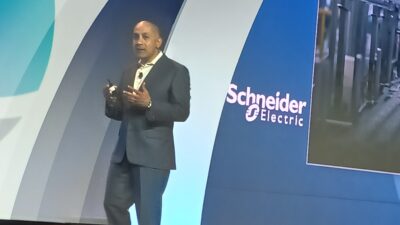Located in Pune, India, Tata Motors manufactures a range of passenger and commercial vehicles including SUVs, small trucks, and hatchbacks. Producing 400,000 vehicles per year, the company reported sales of $4.5 billion U.S. in 2005. With manufacturing facilities in India, Spain, and Korea, Tata Motors has established a solid brand image and is recognized for its ability to produce high-quality...
Located in Pune, India, Tata Motors manufactures a range of passenger and commercial vehicles including SUVs, small trucks, and hatchbacks. Producing 400,000 vehicles per year, the company reported sales of $4.5 billion U.S. in 2005.
With manufacturing facilities in India, Spain, and Korea, Tata Motors has established a solid brand image and is recognized for its ability to produce high-quality vehicles at a cost-effective price–a strategy that has led to its remarkable success.
At its Pune, India facility, Tata Motors manufacturers heavy and light commercial vehicles, pickup trucks, military utility vehicles (MUVs), sport-utility vehicles (SUVs), and passenger cars.
India has three times the population of the U.S., but less than 2% own cars, compared to 45% who own cars in the U.S. In 1996, Tata Motors set out to develop a completely indigenous car for the Indian population, the Indica.
In order to produce the slated 150,000 Indicas per year, Tata Motors decided to build a new plant next to the existing Pune facility. To save money equipping the new facility, the company purchased an existing automotive manufacturing plant in Australia and relocated it to India. The company’s existing Pune production lines consisted of separate islands of automation technology with virtually no integration among systems.
The move from down under
The purchase of the Australian plant gave Tata Motors a good base for its new facility, but it didn’t give the company everything. For one, it had limited experience with automation technology. The experience they did have, however, was with Rockwell Automation. This proved to be a major benefit, since the facility Tata Motors was moving was also equipped with Rockwell Automation control technology.
To meet its goals, Tata Motors needed to make many other changes:
Upgrade the control system to handle production of 150,000 cars per year;
Retool and modifying the production lines to meet the Indicar specifications;
Incorporate flexible manufacturing capabilities to produce cars to meet both European and Indian automotive standards;
Deliver high quality manufacturing while keeping costs below the competition;
Equip the plant with the versatility to manufacture multiple variations of the hatchback car model; and
Complete the transition and bring the new plant online within 18 months. With very little documentation from the Australian facility, Tata Motors faced numerous installation and integration challenges.
The transition team included engineers from Rockwell Automation’s Indian and Australian field offices, and the company’s India distributor, Yantra Automation, who assisted by stocking necessary equipment and providing logistical support. Altogether, more than 50 engineers from Tata Motors, Rockwell Automation, and Yantra Automation were involved in setting up the new facility’s equipment, engineering and automation technology platforms.
Since the control system within the Australian plant provided only about 60% of the total functionality needed to meet Tata Motors’ production and quality requirements, a considerable amount of design, installation, and configuration work had to be completed.
Because the Australian plant’s previous owners failed to keep the control system documentation up to date, Tata Motors relied on Rockwell Automation Australia and India to provide the necessary programming and system engineering capabilities to bring the system up to performance specifications. In addition, Rockwell Automation provided training for Tata Motors engineers on the operation, troubleshooting, and maintenance of the control system.
While the engine and paint line control systems were not changed, the body shop line controls were upgraded to accommodate ControlNet networking for higher capacity data transfer. The upgrade allowed Tata Motors to retain its existing investment in I/O at the Indian plant and integrated all lines to improve coordination.
Rockwell Automation and Yantra Automation formed a transition team to upgrade the control system to a new platform — primarily Allen-Bradley SLC 500 controllers — to automate auxiliary functions and processes, such as material feeder lines, fixture controls, gantry systems, and disc systems. The transition team also assisted Tata Motors with the integration of a new press line as well as integration of the sequential operations with 75 new robots.
From beginning to end, the relocation, integration, and startup of Tata Motor’s new facility took approximately 17 months, which was within the desired time frame. Transforming islands of automation, including new robots, into a completely integrated, automated facility was an enormous undertaking made easier through the relationship with Tata’s supplier and local distributor. In addition, reusing nearly every piece of the Australian plant’s existing control system reduced costs significantly.
The relocation of the facility and upgrade of its control systems helped the company quickly meet its production goals of 150,000 cars per year and reduce its cycle times. Most importantly, the Indica Hatchback entered the market at a quality and price point that the Indian population quickly embraced. Additionally, because of the success of the Indica, Tata Motor’s biggest competitor was forced to drop its price immediately after the car’s introduction.
Adding new products
Due to the success of the Indica and the new Pune facility, Tata Motors decided to add a sedan and wagon to its existing hatchback design and needed the ability to produce three different body styles in the same facility.
The automaker also needed to manufacture cars to meet European and Indian standards. Regulations, performance standards, and safety and emission requirements vary greatly among regions, making compliance particularly challenging. Moreover, the company needed to meet all these requirements with no shutdowns to the existing facility and with no increase in cycle times.
The control system’s flexibility and design made this possible with very few hardware changes. The company was able to leverage ControlNet and its existing control system investment mainly through software modifications. The upgrade also involved adding more I/O, enhancing the functionality of its operator interfaces, integrating a barcode based automatic ID system, modifying fixtures to accommodate the new body styles, and adding another 10 robots to the manufacturing line.
Once again, the results far exceeded Tata Motor’s expectations. Not only were the new models a success, but the company met both European and Indian standards. Furthermore, the production average increased from 400 to 650 cars a day.
New mini weld line
Tata Motors saw an additional opportunity to increase production capacity through the addition of a mini weld line. For the line’s control platform, Tata Motors chose Rockwell Automation’s ControlLogix programmable automation controllers and PanelView Plus operator interfaces, as well as an open network architecture utilizing DeviceNet and EtherNet/IP networks. Using the Logix control platform, Tata Motors leveraged its previous experience with the PLC-5 programmable logic controller systems, enabling them to reuse their initial I/O investment and integrate the I/O with the new control platform. The implementation of the Logix-based mini weld line allowed the company to increase production from 650 cars per day to 750.
The company is now setting its sights on producing 1,000 cars per day at the Pune facility. To meet this goal, it will need to find additional ways to reduce cycle times. To achieve this goal, the company is working with its supplier to run benchmark studies to determine the necessary cycle times.
The auto manufacturer has other ambitious plans for the future that go beyond the Indica, including globalization, faster growth, additional exports, production of aftermarket components, and preparing for new competition. The experience Tata Motors has gained will provide a foundation for successful automation of additional lines.
Eventually, Tata Motors would like to migrate all automation systems to the Logix platform and integrate via EtherNet/IP networking because of its worldwide acceptance. Furthermore, it plans to use the Rockwell Automation Integrated Architecture to provide higher-level business systems with actionable information from the plant floor for better decision making.
Author Information
K.K. Mitra is Tata Motors Key Account Manager at Rockwell Automation. Contact him at [email protected]



